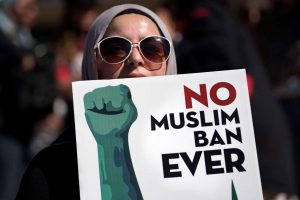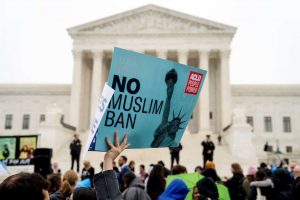JUNE 26, 2018
 An activist holds a sign during a protest against President Trump’s travel ban in Los Angeles, California on October 15, 2017. The No Muslim Ban Ever rally was organized by the Council on American-Islamic Relations in response to the Trump administrations third iteration of the of the travel ban. – Ronen Tivony/NurPhoto via Getty Images
An activist holds a sign during a protest against President Trump’s travel ban in Los Angeles, California on October 15, 2017. The No Muslim Ban Ever rally was organized by the Council on American-Islamic Relations in response to the Trump administrations third iteration of the of the travel ban. – Ronen Tivony/NurPhoto via Getty Images
WASHINGTON, D.C. — The Supreme Court Tuesday upheld President Trump’s ban on foreign visitors and immigrants from six nations, ruling that the chief executive, acting on his own, has the power to target foreign nations and block their citizens from entering this country.
By a 5-4 vote, the justices rejected arguments that Trump overstepped his authority under the immigration laws and that his targeting of mostly Muslim-majority countries amounted to unconstitutional religious discrimination.
The ruling is a major victory for Trump and his administration as well as an implicit rebuke to the judges on the East and West coasts who repeatedly issued nationwide orders to block the travel ban.
It also comes as the Trump administration is aggressively pressing its “zero tolerance” policy against foreigners who illegally cross the southern border. That in turn has sparked a national backlash because thousands of children have been forcibly separated from their parents who are being held in immigration jails.
While Tuesday’s ruling does not deal with the arrest or prosecution of border crossers, it will likely be cited by Trump’s lawyers as bolstering the government’s authority along the borders.
The controversy over the ban began during Trump’s first week in the White House. During his campaign, he had promised to impose a “total and complete shutdown of Muslims entering the United States,” and a few days after being sworn in, he issued a hastily drafted proclamation that temporarily barred foreign travelers from seven countries. Trump’s lawyers defended the 90-day order by citing the federal immigration law that says the president may “suspend the entry of … any class of aliens” if he thinks they would be “detrimental to the interests of the United States.”
The surprise travel ban caused chaos at airports around the world and disrupted the plans of thousands of students, business travelers and tourists. In the first of many such rulings, a federal judge in Seattle issued an order putting Trump’s proclamation on hold. Two months later, the White House issued a second, revised travel order.
 A person holds up a sign that reads “No Muslim Ban” during an anti-Muslim ban rally. – Andrew Harnik
A person holds up a sign that reads “No Muslim Ban” during an anti-Muslim ban rally. – Andrew Harnik
The 9th Circuit Court of Appeals in California, along with the 4th Circuit in Virginia, upheld the district judges who had blocked Trump’s order. But the Supreme Court ended its term last year by issuing a middle-ground ruling that allowed the travel ban to take effect, except for foreign visitors who have a close family tie or business affiliation in the United States.
Trump’s second order expired as planned last fall, and the White House then issued a third and permanent order that barred entry for most visitors and immigrants from Iran, Libya, Chad, Syria, Somalia, Yemen and North Korea, although Chad later was removed from the list. Once again, federal judges in Hawaii and Maryland issued nationwide orders to block enforcement of Trump’s proclamation, and their decisions were upheld by the 9th and 4th Circuits.
But it became clear the Supreme Court was prepared to rule for the administration. In December, the justices issued an order at the behest of Trump’s lawyers that set aside the lower court rulings and allowed the travel ban to take full effect.
The court then scheduled oral arguments for April in the case of Trump vs. Hawaii, but it seemed apparent a decision already had been reached.
Courtesy/Source: LA Times










































































































